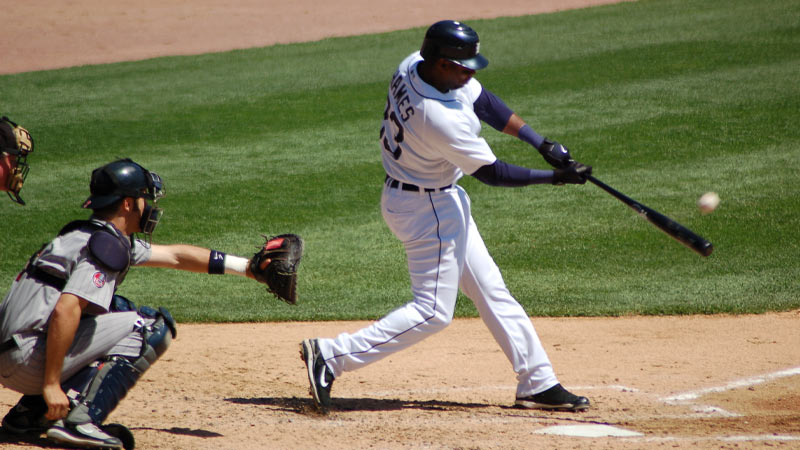Baseball, often referred to as America’s favorite pastime, is a sport with a rich history and a treasure trove of statistics that captivate fans and enthusiasts alike.
Among these numbers, batting stats hold a special place as they provide crucial insights into a player’s hitting prowess and offensive impact on the game.
From batting average to slugging percentage, these metrics shed light on a player’s consistency, power, and ability to drive in runs.
Whether you’re a die-hard fan or a casual observer, understanding how baseball batting stats work is essential to appreciate the brilliance of players and the strategic decisions made by teams.
In this blog post, we’ll delve into the frequently asked questions surrounding these stats to help you unlock the secrets behind the numbers.
What is the Bating Stats in Baseball?
In baseball, batting stats are crucial metrics that assess a player’s performance at the plate. These statistics gauge a player’s hitting abilities and offensive contribution to the team.
The primary batting stats include batting average (AVG), which is the ratio of hits to at-bats, providing a measure of consistency. On-base percentage (OBP) factors in walks and hit-by-pitches, measuring a player’s ability to reach base.
Slugging percentage (SLG) evaluates power-hitting by considering the total bases earned per at-bat. On-base plus slugging (OPS) combines OBP and SLG to offer a comprehensive offensive indicator.
Additionally, stats like runs batted in (RBI), home runs (HR), doubles (2B), and triples (3B) showcase a player’s ability to drive in runs and hit for extra bases. These statistics play a significant role in player evaluations, comparisons, and strategic decision-making in baseball.
How Do Baseball Batting Stats Work?

Source: blessyouboys.com
Baseball batting stats work by collecting and recording data on a player’s performance at the plate during games. These statistics are used to evaluate a player’s hitting abilities, measure their offensive contribution to the team, and make comparisons with other players.
Here’s how baseball batting stats work:
At-Bat (AB)
An at-bat is an official plate appearance where a player has the opportunity to hit the ball. It excludes walks, sacrifices, hit-by-pitches, and catcher interference.
Hit (H)
A hit occurs when the batter safely reaches a base after putting the ball in play and is not due to an error or fielder’s choice. Hits are further categorized into singles, doubles, triples, and home runs based on the number of bases a player reaches.
Walk (BB)
A walk (also known as a base on balls) happens when the pitcher throws four pitches outside the strike zone, and the batter is awarded first base without putting the ball in play.
Strikeout (K)
A strikeout occurs when a batter receives three strikes during an at-bat and fails to put the ball in play. The catcher must successfully catch the third strike for the out to be recorded.
Sacrifice (SAC)
A sacrifice happens when a batter intentionally gives up their at-bat to advance a baserunner. There are two types of sacrifices: sacrifice bunt (SAC B) and sacrifice fly (SAC F).
Hit-by-Pitch (HBP)
A hit-by-pitch occurs when a batter is struck by a pitch thrown by the pitcher, and they are awarded first base as a result.
Error (E)
An error is charged to a fielder when they make a mistake that allows a batter to reach base safely when they should have been put out.
Batting Average (AVG)
The batting average is calculated by dividing the total number of hits by the total number of at-bats. It is represented as a decimal rounded to three decimal places.
On-Base Percentage (OBP)
On-base percentage is calculated by dividing the sum of hits, walks, and hit-by-pitches by the sum of at-bats, walks, hit-by-pitches, and sacrifice flies. It is represented as a decimal or percentage.
Slugging Percentage (SLG)
The slugging percentage is calculated by dividing the total bases (1 for a single, 2 for a double, 3 for a triple, and 4 for a home run) by the total number of at-bats. It is also represented as a decimal or percentage.
On-Base Plus Slugging (OPS)
OPS is the sum of a player’s on-base percentage and slugging percentage. It provides a more comprehensive measure of a player’s offensive performance.
These statistics are recorded and compiled throughout the baseball season and are used by teams, analysts, and fans to assess player performance, make strategic decisions, and analyze trends in the sport.
Significance of Bating States in Baseball

Source: wikipedia.org
Batting stats in baseball hold significant importance as they provide a detailed and objective assessment of a player’s offensive performance.
These statistics offer valuable insights for players, coaches, team managers, fans, and analysts. Here are some key reasons for the significance of batting stats:
Player Evaluation
Batting stats allow teams to evaluate individual players’ hitting abilities, identifying strengths and weaknesses. It helps in making informed decisions regarding player roles, lineup positions, and potential roster changes.
Performance Comparison
By comparing batting stats, teams can gauge how well a player performs relative to their peers, both within their own team and across the league.
Offensive Contribution
Batting stats quantify a player’s offensive impact on the team’s overall performance. A player with high batting averages, on-base percentages, and slugging percentages can significantly boost the team’s chances of scoring runs and winning games.
Strategic Decision-Making
Coaches and managers use batting stats to devise game strategies, such as determining optimal batting orders and pinch-hitting opportunities.
Fan Engagement
Batting stats add to the excitement of the sport, allowing fans to follow and discuss a player’s performance and achievements.
Historical Comparisons
Batting stats create a historical record of player achievements, enabling comparisons between players of different eras and assessing their places in baseball history.
Contract Negotiations
Players and agents use batting stats to negotiate contracts, as strong offensive performances can enhance a player’s market value.
The batting stats serve as a critical tool for understanding a player’s offensive impact on the game, shaping team strategies, and providing fans with a deeper appreciation of the sport.
How Do You Calculate Batting Stats?
Calculating batting stats in baseball involves simple mathematical formulas using the data collected during games. Here are the key batting stats and their respective calculations:
Batting Average (AVG):
Batting Average = Total Hits (H) / Total At-Bats (AB)
On-Base Percentage (OBP):
On-Base Percentage = (Total Hits (H) + Total Walks (BB) + Total Hit-by-Pitches (HBP)) /
(Total At-Bats (AB) + Total Walks (BB) + Total Hit-by-Pitches (HBP) + Total Sacrifice Flies (SF))
Slugging Percentage (SLG):
Slugging Percentage = (Total Bases (TB)) / Total At-Bats (AB)
On-Base Plus Slugging (OPS):
On-Base Plus Slugging = On-Base Percentage (OBP) + Slugging Percentage (SLG)
Runs Batted In (RBI):
Runs Batted In = The number of runs scored by baserunners due to a player’s hits or sac flies.
Home Runs (HR):
Home Runs = The total number of times a player hits the ball out of the park.
Doubles (2B):
Doubles = The total number of hits resulting in a double.
Triples (3B):
Triples = The total number of hits resulting in a triple.
Remember, these calculations rely on accurate and consistent data collection, and the stats may vary depending on the level of play (e.g., Major League Baseball, Minor League Baseball, amateur leagues). These stats help assess a player’s offensive performance and contribute to their overall evaluation of the sport.
How to Read the Baseball Bating Statistics?
Reading baseball batting statistics involves understanding the various metrics and their implications for a player’s offensive performance. Here’s a step-by-step guide to reading batting stats:
Batting Average (AVG)
This represents a player’s hitting consistency and is displayed as a decimal rounded to three decimal places. For example, a player with a batting average of .300 has successfully hit the ball in 30% of their at-bats.
On-Base Percentage (OBP)
OBP measures a player’s ability to get on base and is also represented as a decimal or percentage. A player with an OBP of .400 reaches base safely in 40% of their plate appearances.
Slugging Percentage (SLG)
SLG indicates a player’s power-hitting ability and is represented as a decimal or percentage. A player with an SLG of .500 earns an average of 0.5 bases per at-bat.
On-Base Plus Slugging (OPS)
OPS is the sum of OBP and SLG and gives a comprehensive view of a player’s offensive contribution. An OPS of .900 is considered excellent.
Runs Batted In (RBI)
RBI counts the number of runs a player has driven in with their hits. It shows a player’s ability to produce runs.
Home Runs (HR)
This stat reflects the number of times a player has hit the ball out of the park.
Doubles (2B) and Triples (3B)
These stats indicate the number of hits resulting in a double or triple, respectively.
Walks (BB) and Strikeouts (K)
These show a player’s patience at the plate (walks) and their ability to avoid strikeouts.
Reading these statistics helps fans, analysts, and team managers assess a player’s offensive performance, compare players, and understand their overall contribution to the team.
Additionally, understanding these stats allows fans to have more meaningful discussions and a deeper appreciation for the game of baseball.
FAQs
What is batting average, and why is it important?
Batting average (AVG) is the ratio of a player’s total hits to their total at-bats. It represents a player’s hitting consistency and is one of the most commonly cited statistics in baseball. A higher batting average indicates a more proficient hitter, while a lower average suggests room for improvement.
How is an on-base percentage (OBP) different from the batting average?
On-base percentage (OBP) takes into account not only hits but also walks and hit-by-pitches to measure a player’s ability to reach base. It provides a broader view of a player’s offensive contribution and emphasizes their plate discipline.
What does slugging percentage (SLG) reveal about a player’s hitting power?
Slugging percentage (SLG) focuses on a player’s power-hitting abilities. It calculates the total bases earned per at-bat, emphasizing extra-base hits. A higher SLG indicates a player who can consistently hit for power.
How do analysts use on-base plus slugging (OPS) to evaluate players?
On-base plus slugging (OPS) combines a player’s on-base percentage and slugging percentage to create a comprehensive offensive statistic. Analysts use OPS to compare players’ overall offensive impact and assess their value to the team.
Are there any limitations to relying solely on batting stats for player evaluation?
While batting stats provide valuable insights, they have limitations. They don’t consider a player’s defensive abilities, baserunning, or their performance in high-pressure situations. To form a complete assessment, teams, and analysts consider a range of stats and qualitative factors.
Bottom Line
Batting stats are the backbone of baseball analysis, offering a window into a player’s hitting abilities and their influence on the game’s outcome. From batting average to OPS, each statistic brings a unique perspective to a player’s offensive performance.
By understanding how these baseball batting stats work, fans can truly appreciate the skills of their favorite players and marvel at the strategic decisions made by teams.
As the season unfolds, armed with this knowledge, fans can dive deeper into the thrilling world of baseball and engage in discussions that celebrate the artistry and science behind the sport.







